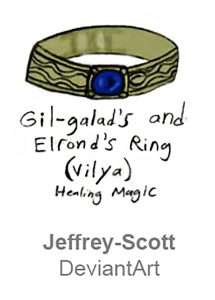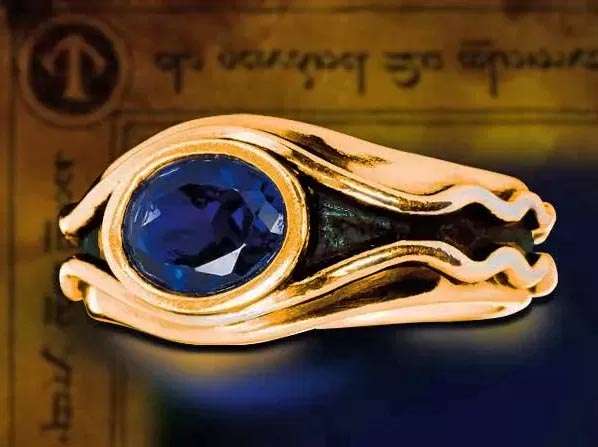In this episode of Three Rings for the Elven Kings, we’ll be looking at the Ring of Air, Vilya. Vilya was Elrond’s Ring (and before him, Gil-Galad’s). We’re going to assume going forward you have sufficient nerd blood in ya that we don’t have to explain everything.
Vilya: Elrond’s Ring
Mike Searson
Elrond’s ring was called Vilya. It was one of the three Elven Rings of Power (the only three of the Free Peoples’ 19 crafted without interference by Sauron).
“Three Rings for the Elven-kings under the sky,
Seven for the Dwarf-lords in their halls of stone,
Nine for Mortal Men doomed to die,
One for the Dark Lord on his dark throne
In the Land of Mordor where the Shadows lie.
One Ring to rule them all, One Ring to find them,
One Ring to bring them all and in the darkness bind them
In the Land of Mordor where the Shadows lie.”
If you’ve seen, or more importantly read The Lord of the Rings, you’re undoubtedly familiar with that rhyme. The books, in particular, go into much more depth than the films went. It’s possible for some people to view the movies and not realize that there were other magical rings in Tolkien’s Middle Earth. Most significant were the Three Elven rings.
Vilya’s History
The Elven rings are probably the most famous beyond the One Ring that rules all of the others. They were forged by Celebrimbor, an Elvish prince and master smith who learned metal working from the Dwarves. He forged the Three Elven Rings (Narya, Vilya and Nenya) alone and not under the watchful eye of Sauron who was teaching other Elvish smiths how to make rings. Although, Sauron never so much as ever saw or touched these rings, his magical techniques allowed them to fall under the control of the One Ring. His intent was to control the others who bore these rings whom were all in positions of power and would in turn grant him power over all of Middle Earth.
One of these rings was called Vilrya; which means the Ring of Air. It is described as a gold band set with a blue sapphire.
According to Tolkien’s Unfinished Tales, this ring was entrusted to Gil-Galad, the last High King of the Western Elves along with Narya, the Ring of Fire.
Elrond, Lord of Rivendell and Herald of Gil-Galad inherited Vilya after Gil-Galad was killed by fire from the severed hand of Sauron, after the latter’s death.
It has been speculated by fans that Vilya may have been the reason why Rivendell was so prosperous and successful, because of the powerful magic that it contained.
Powers of Elrond’s Ring
While the powers of Vilya are never specifically mentioned, in The Return of the King it is said that of the three rings Vilya was the most powerful. According to The Silmarillion, all three of the rings were imbued with powers of healing and protection. Perhaps Elrond’s powers of healing were either from Vilya or enhanced by it.
Elrond’s ability to summon a waterspout against the Nazgûl who were after Sam and Frodo may have been another of the ring’s powers.
Additionally, these three rings are invisible while they are worn. This is more explicitly stated at the end of The Return of the King when Elrond prepares to set sail to the Grey Havens after the One Ring is destroyed and the ring is plainly visible on his finger.
It is speculated by Tolkien researchers that Tolkien simply did not have enough time to fully flesh out the powers of these rings because it might have detracted from the story of the One Ring.
Regardless, it is safe to say that when the One Ring was destroyed, rings like Vilya lost all of their powers and were no longer needed. Its magic died in the fires of Mount Doom as the One Ring was destroyed.

Vilya (Elrond’s Ring) was one of the three elven rings. It was referred to as the “Ring of Air”. Artwork by Jeffrey-Scott on DeviantArt.
At this time, the first Council was held, and it was there determined that an Elvish stronghold in the east of Eriador should be maintained at Imladris rather than in Eregion. At that time, also Gil-galad gave Vilya, the Blue Ring, to Elrond, and appointed him to be his vice-regent in Eriador; but the Red Ring he kept, until he gave it to Círdan when he set out from Lindon in the days of the Last Alliance. ¹¹ For many years the Westlands had peace, and time in which to heal their wounds; but the Númenóreans had tasted power in Middle-earth, and from that time for- ward they began to make permanent settlements on the western coasts [dated ‘c. 1800’ in the Tale of Years], becoming too powerful for Sauron to attempt to move west out of Mordor for a long time.









0 Comments